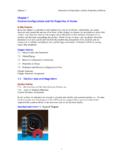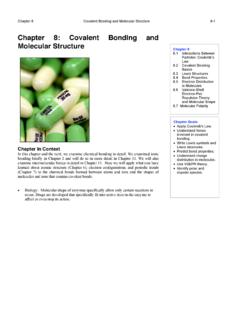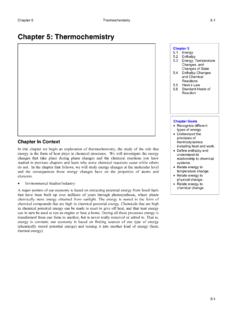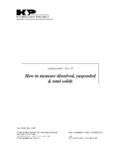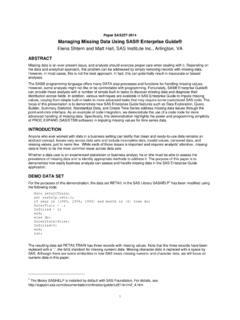Transcription of Evaluation of chlorophyll a extraction techniques - …
1 Evaluation of chlorophyll a extraction techniques Marissa Mehlrose1 and Kiyoko Yokota2 INTRODUCTION chlorophyll a is a pigment essential for electron transport during photosynthesis, making it vital to the success of all photosynthetic organisms. Because it is found in all organisms that photosynthesize, and its concentration is relative to the biomass of the organism, it is commonly used as an indicator of the planktonic algal biomass in water samples (Wasmund et al. 2006). The process of extracting the chlorophyll a from the sample appears to be a key step in chlorophyll a analysis; in order to get the accurate and most consistent results, it is important to determine which method of extraction is the best (Simon and Helliwell 1998). Typically, chlorophyll a determinations involve passing raw water through glass fiber microfilters to remove algae from the samples, then performing methods to extract chlorophyll a from these filters through chemical and physical means (APHA 1989).
2 Despite the extraction being such an important step, there is still conflicting evidence on which methods are most effective (Simon and Helliwell 1998; Nelson 1981). Some suggest that disrupting the cell wall mechanically and creating a homogeneous mixture is the best way to ensure all chlorophyll a is extracted (Simon and Helliwell 1998), while others suggest that leaving the cells intact in solution is just as efficient (Saratory and Grobbelaar 1984). The ability of certain solvents to facilitate extraction has also been debated, as some report that acetone is not effective on green algae (chlorophytes) and blue-green algae (cyanophytes) (Arvola 1981; Shoaf and Lium 1976), though it has been commonly used (APHA 1989). It has also been suggested that ethanol is a better solvent choice because it is safer to work with, and that it works well with all phyla of algae (Arvola 1981). filter type could also influence reported chlorophyll a concentrations, as filters with smaller pores would be expected to collect smaller-celled (nano- and pico-) phytoplankton.
3 Additionally, chlorophyll a extraction could be a function of the amount of time that the processed filter is subjected to chemical extraction by the solvent. Historically, chlorophyll a processing at the BFS lab has involved passing water through a GF/A glass microfiber filter under low pressure vacuum. Filters were cut into pieces, placed in a grinding tube to which 90% buffered acetone had been added, and ground into a slurry with a 1 Department of Marine Biology and Environmental Science, University of New Haven. 2 Assistant Professor of Biology, SUNY Oneonta. grinding pestle. After approximately two hours of incubation followed by centrifugation, chlorophyll a in the supernatant was determined fluorometrically according to Arar and Collins (1997). While providing reasonably reproducible results, the process was time consuming and not proven to be optimal. This experiment aimed to evaluate the combinations of solvent type, glass filter pore size, and the inclusion of physical disruption ( , use of a tissue grinder) on the effectiveness of chlorophyll a extraction from surface waters.
4 After this work commenced, preliminary results indicated that measuring chlorophyll a immediately after processing the filters resulted in underestimation of chlorophyll a concentrations. Therefore, the additional variable included in the matrix was whether chlorophyll a was determined immediately after extraction or whether it was held to steep (soak) in the solvent for three hours prior to determination. METHODS Samples were analyzed from two water bodies in Otsego County, New York. Otsego Lake (Figure 1) is a deep oligotrophic lake of glacial origin (Waterfield and Albright 2016). Conversely, Moe Pond (Figure 2) is a shallow, eutrophic pond (Busby and Casscles 2016). Sampling water from two such distinct sources was intended to represent samples having distinct and variable algal communities, including differing taxa and cell size distributions. In order to determine which method of chlorophyll a extraction worked best, different combinations of filter paper , solvent, and sample extraction methods were used to determine which combination produced the highest and most consistent concentrations, thus providing the best results.
5 Initial work compared a 3 hour soaking (or steeping ) step during the extraction process vs. immediate sample processing following sample filtration and placement of the filter into the solvent. The combinations of each of these four variables yielded sixteen distinct iterations, which are summarized in Table 1. These sixteen methods were evaluated on both Otsego Lake and Moe Pond samples, with each Evaluation having five trials. Table 1. Thirty-two (= 25) combinations of the five major factors in chlorophyll a extraction , each with two levels, that were evaluated. N = 5 for each of 32 combinations, resulting in 25 5 = 160 samples total. Solvent type Grinding filter Type Steeping Sample source Buffered acetone Ground GF/A No steeping Otsego Lake (oligotrophic) Ethanol Not ground GF/F 3 hour steeping Moe pond (eutrophic) Collection Using a 20-liter carboy, 12 liters of water were collected from Rat Cove in Otsego Lake (Figure 1) on 7 July 2016 and from Moe Pond (Figure 2) on 20 July 2016.
6 These samples were transported in low light conditions, and all work was performed in low light to minimize degradation of chlorophyll a (APHA 1989). Sub-samples of the water from the lake and pond were preserved with approximately 1 mL of Lugol s iodine for later microscopic Evaluation of algal communities. Figure 1. The location of sampling in Otsego Lake in Cooperstown, NY (from Waterfield and Albright 2016 ). Sample site Figure 2. The location of Moe Pond in Cooperstown, NY (from Busby and Casscles 2015). Processing Samples were filtered immediately to prevent degradation of chlorophyll a. For Otsego Lake samples, a volume of 250 mL was filtered, and for Moe Pond samples, 100 mL was filtered. This was based on the chlorophyll a concentration ranges anticipated. Two types of cm diameter Whatman glass microfiber filters were compared: GF/A filter papers (having a pore size of m) and GF/F filter paper (having a pore size of m).
7 All samples were filtered using a low pressure (15 psi) vacuum pump. Once filtration was complete, filters were folded in half with the exposed side inside, gently pressed onto paper towel to remove excess water, and the edges not contacted by the sample were trimmed. Each filter was stored in a petri dish wrapped in aluminum foil and stored at -4 C for 21- 24 hours. A total of 160 filters were preserved, 80 for each Otsego Lake and Moe Pond samples (Table 1). Half of the filters used were GF/A filters and half were GF/F filters (see above). In all cases, using fine scissors, the filters were cut into small (~ 3 mm x 3 mm) pieces. Half of each of these filters were extracted using buffered acetone, the other half using ethanol. Half of each of these treatments were ground to a slurry using a Teflon pestle chucked in an electric drill and a grinding tube (with the pestle and tubes being rinsed well between samples to avoid cross-contamination), the other half were not ground.
8 Both the cut up filter pieces and the ground slurries were transferred to 15 ml centrifuge tubes and the volume of solvent was taken up to 10 ml. Half of each of these treatments were allowed to steep for three hours under refrigeration, the other half were processed immediately. At the appropriate times (either immediately or after three hours), the samples were centrifuged at 10,000 xG for ten minutes and chlorophyll a concentrations were determined on the supernatant using a Turner Designs TD 700 fluorometer using the methods of Arar and Collins (1997). Algal Analysis Ten milliliters of algal samples preserved with Lugol s iodine were poured into an Uterm hl settling chamber and refrigerated for a minimum of 24 hours to allow the phytoplankton cells to sink to the bottom of the chamber. The algal cells were identified and enumerated using an inverted microscope under a 40 x objective using taxomic keys by Bellinger and Sigee (2010) and Prescott (1964).
9 RESULTS Figure 3 compares chlorophyll a concentrations from samples collected from the oligotrophic Otsego Lake, processed using different filter types, extraction solvents, filter grinding vs no grinding, and steeping vs no steeping. When compared to the same filter and extraction method, all filters with an extraction time of 3 hours showed higher chlorophyll a concentrations than those that were centrifuged immediately after filtering (no steep). Figure 3. Comparison of Otsego Lake chlorophyll a values when the filters were allowed to steep for three hours compared to values being obtained immediately after filtering. GF/A no steep and GF/F no steep were processed immediately (without a steeping period), while GF/A 3 hr. steep and GF/F 3 hr. steep had an extraction time of 3 hours before processing. Otsego Lake chlorophyll a concentrations derived from the different filter types were similar when those filters were ground as part of the extraction process.
10 However, the GF/F filters provided higher chlorophyll a concentrations when the filters were not ground. Not grinding the samples resulted in more consistent chlorophyll a concentrations, and when the GroundAcetone Not GroundEthanol GroundEthanol Not GroundChlorophyll a concentration ( g/L) Method GF/A 2GF/A 1GF/F 2GF/F 13 hr. steep 3 hr. steep no steep no steep filters were not ground, acetone was somewhat more effective as an extractant than was ethanol (Figure 4). Figure 4. Comparison of methods used to obtain chlorophyll a concentrations on two different filter types and extraction methods using water from Otsego Lake, NY. The eutrophic Moe Pond samples also indicated that GF/F filters were more effective than GF/A filters, and not grinding the filters resulted in the highest chlorophyll a concentration (Figure 5). Acetone resulted in somewhat higher chlorophyll a concentrations than ethanol in the Moe Pond water samples. Figure 5. Comparison of methods used to obtain chlorophyll a concentrations on two different filter types and extraction methods using water from Moe Pond, NY.


